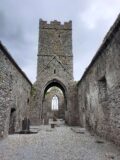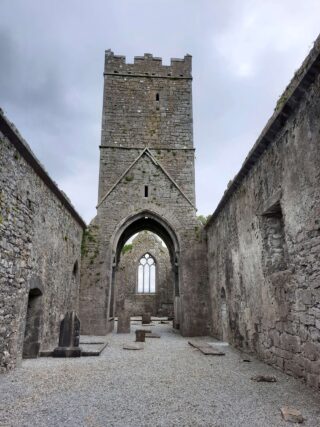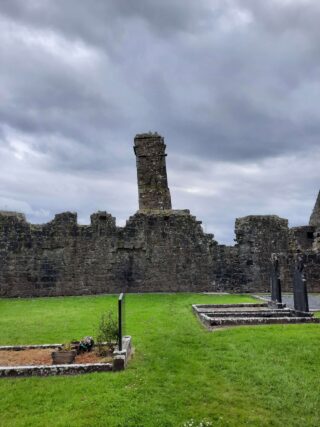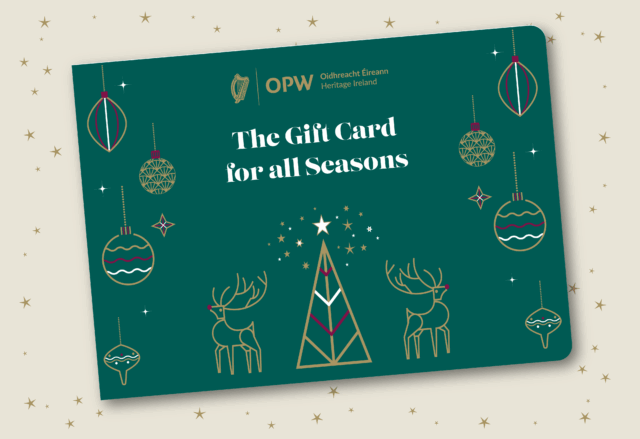Notice
Clare Abbey is a National Monument in state guardianship
WARNING: It should be noted that these sites are unguided and a level of care and caution should be maintained during all stages of your visit. The Office Of Public Works (OPW) will not be held responsible for any damages, injuries, or losses that occur
Clare Augustinian Abbey
Clareabbey (also known as Clare Abbey) is an Augustinian monastery ruin located to the west of the River Fergus at the end of a narrow slip road at the south east corner of the town of Ennis. When in operation it was the largest and most important of Co. Clare’s Augustinian monasteries.
Originally called the ‘Abbey of St. Peter & Paul at Kilmony’, it was founded in about 1189, reportedly by Domnall Mór Ua Briain (Donald O'Brien), the King of Thomond, who died in 1194.
The remains of the abbey consist of a church with a handsome square belfry tower and several domestic buildings to the south and east of the church, all surrounding a garden cloister. Unusually, there is no sign that a west range of buildings ever existed. As with so many medieval ecclesiastical ruins, some of the existing interior ground has been subsequently used for burials by local families. A large Victorian tomb was erected in 1871 in the east range beside the choir end of the church for himself and his family by Thomas Crowe Esq. D. L., of Dromore House, Ruan, Co. Clare.
Dating in parts to the 12th century, the church consists of a long single-aisle nave and chancel, which are separated by the belfry tower, which is missing its internal staircase. The additional buildings date from the 15th century from which time three important windows and their elegant tracery are still intact. The west window has completely collapsed.
The monastery was dissolved by King Henry VIII of England in 1541, although it appears to have been occupied by the Canons of the order as late as 1650.
The most notable architectural features in the abbey are the three inserted fifteenth-century tracery windows. Of the two that are in the chancel, the pointed three-light east window has a small carving of a human face above the hood. An elaborate tracery design, consisting of six trefoils and a quatrefoil, and set in a richly moulded projecting hood, can be seen above the original window in the south gable of the east range.
Loose stones that were once visible in the buildings were repaired and reset in 1898 and 1899, and a large tomb, lacking any inscription, once lay in the north recess under the tower. Evidence exists of an incised post-Norman cross. In the 19th century, the oldest legible tombs dated from the end of the seventeenth century, though subsequent weathering has now rendered many of them illegible.
From recent archaeological revelations, it appears that from the 12th century onwards wine and storage containers were imported to the abbey from southwest France and Bristol and that a rich diet of beef, pork, mutton and fish was enjoyed by the monks.
Protect our Past - Click here to read about the importance of protecting our country’s unique heritage sites
This national monument is protected in accordance with the National Monuments Acts 1930 to 2014
Gallery
Nearby sites to visit
Ennis Friary
Admire some exquisite Renaissance carvings
Approx. 2.1 km from Clare Augustinian Abbey
Askeaton Castle
A ruined stronghold of the earls of Desmond
Approx. 25.4 km from Clare Augustinian Abbey
Adare Castle
Discover a medieval masterpiece, built for defence
Approx. 31.8 km from Clare Augustinian Abbey
Desmond Castle Newcastlewest
Where sounds of medieval revelry echo around the walls
Approx. 42.5 km from Clare Augustinian Abbey
Scattery Island Monastic Site and Visitor Centre
Discover the History, Myth and Legend of Scattery Island
Approx. 44.2 km from Clare Augustinian Abbey
Lough Gur Visitor Centre and Lakeshore Park
9,000 years of life
Approx. 45.5 km from Clare Augustinian Abbey




